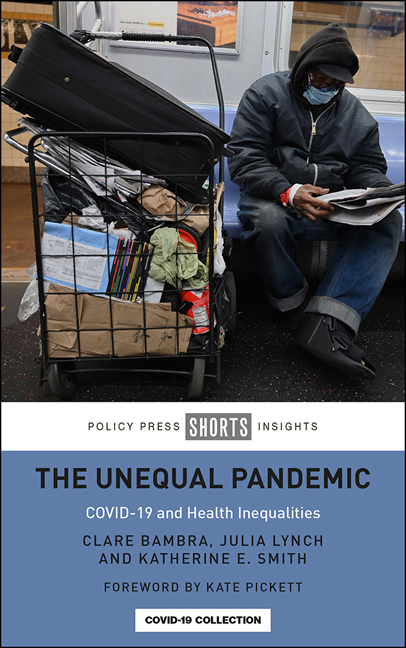Book contents
- Frontmatter
- Contents
- List of figures and tables
- About the authors
- Acknowledgements
- Foreword
- Preface
- one Introduction: perfect storm
- two Pale rider: pandemic inequalities
- three Collateral damage: inequalities in the lockdown
- four Pandemic precarity: inequalities in the economic crisis
- five Pandemic politics: inequality through public policy
- six Conclusion: health and inequality beyond COVID-19
- Notes
- References
- Index
four - Pandemic precarity: inequalities in the economic crisis
Published online by Cambridge University Press: 04 January 2022
- Frontmatter
- Contents
- List of figures and tables
- About the authors
- Acknowledgements
- Foreword
- Preface
- one Introduction: perfect storm
- two Pale rider: pandemic inequalities
- three Collateral damage: inequalities in the lockdown
- four Pandemic precarity: inequalities in the economic crisis
- five Pandemic politics: inequality through public policy
- six Conclusion: health and inequality beyond COVID-19
- Notes
- References
- Index
Summary
The strong do what they can and the weak suffer what they must.
Thucydides, 431 BCIntroduction This chapter examines the COVID-19 economic crisis, an economic shock of rare and extreme impact. COVID-19 has had a devastating impact on the world economy with huge reductions in productivity and national income, and record levels of unemployment (for example and 5.2 million people filed for unemployment benefit in just one week in April 2020 in the US). It is widely feared that the economic impact will be far greater than that of the global financial crisis of 2007/ 8, and that it is likely to be worse in depth than the Great Depression of the 1930s. Emerging contemporary data and research from previous recessions suggest that the economic fallout from the COVID-19 pandemic will have huge consequences for health and health inequalities. This chapter will provide an overview of the unequal impacts of COVID-19 in terms of the social and spatial distribution of the economic crisis. It will then use evidence from previous recessions (such as the global financial crisis of 2007/ 8) to explore the likely unequal health impacts and reflect on the role of social safety nets in preventing them.
An unequal crisis
The impact of COVID-19 on health inequalities will not just be in terms of virus-related infection and mortality, but also in terms of the health consequences of the policy responses undertaken in most countries. Traditional public health surveillance measures of contact tracing and individual quarantine were successfully pursued by some countries (most notably by Australia, South Korea and Germany) as a way of tackling the virus in the early stages. However, most other countries failed to employ this approach successfully, so governments worldwide were eventually forced to implement mass quarantine measures in the form of lockdowns and social distancing. These state-imposed restrictions, usually requiring the government to take on emergency powers, have been implemented to varying levels of severity, but all have in common a significant increase in social isolation and confinement within the home and immediate neighbourhood.
- Type
- Chapter
- Information
- The Unequal PandemicCOVID-19 and Health Inequalities, pp. 55 - 76Publisher: Bristol University PressPrint publication year: 2021



